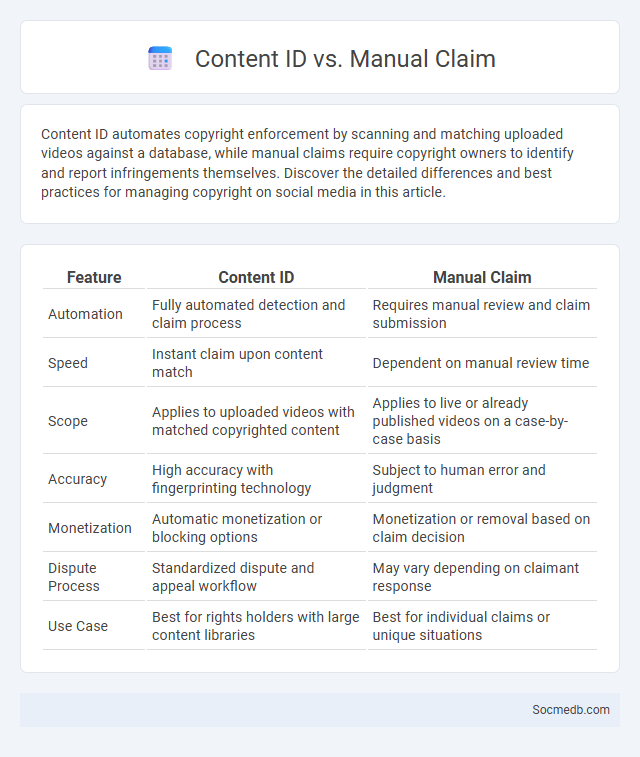
Photo illustration: Content ID vs Manual Claim
Content ID automates copyright enforcement by scanning and matching uploaded videos against a database, while manual claims require copyright owners to identify and report infringements themselves. Discover the detailed differences and best practices for managing copyright on social media in this article.
Table of Comparison
| Feature | Content ID | Manual Claim |
|---|---|---|
| Automation | Fully automated detection and claim process | Requires manual review and claim submission |
| Speed | Instant claim upon content match | Dependent on manual review time |
| Scope | Applies to uploaded videos with matched copyrighted content | Applies to live or already published videos on a case-by-case basis |
| Accuracy | High accuracy with fingerprinting technology | Subject to human error and judgment |
| Monetization | Automatic monetization or blocking options | Monetization or removal based on claim decision |
| Dispute Process | Standardized dispute and appeal workflow | May vary depending on claimant response |
| Use Case | Best for rights holders with large content libraries | Best for individual claims or unique situations |
Introduction to Copyright on YouTube
YouTube enforces strict copyright policies to protect original content creators and prevent unauthorized distribution of videos. Understanding YouTube's Content ID system is crucial, as it automatically scans uploads for copyrighted material and allows rights holders to claim or monetize videos. Creators must ensure their content complies with copyright laws to avoid strikes, demonetization, or removal of their videos from the platform.
What is Content ID?
Content ID is a digital fingerprinting system developed by YouTube that identifies and manages copyrighted material within uploaded videos. It automatically scans and matches user-uploaded content against a database of copyrighted works, enabling rights holders to monetize, block, or track unauthorized use. This technology protects intellectual property while maintaining compliance with copyright laws across millions of uploads daily.
Understanding Manual Claims
Understanding manual claims in social media involves analyzing user-reported content violations and disputes that automated systems may not accurately process. Manual review ensures accurate enforcement of community guidelines by evaluating context, authenticity, and intent behind posts or interactions. Effective management of these claims improves platform safety, enhances user trust, and reduces false positives in content moderation.
Overview of Copyright Claims
Social media platforms implement copyright claims to protect original content creators by monitoring and removing unauthorized use of copyrighted material. These systems use automated tools and user reports to identify potential infringements, ensuring that your intellectual property rights are upheld and compensated properly. Understanding the copyright policies of each platform helps you navigate content sharing while minimizing the risk of claim disputes.
How Content ID Works
Content ID is a powerful digital fingerprinting system used by YouTube and other platforms to identify copyrighted material within user-uploaded videos. It scans your content against a vast database of copyrighted audio and video files, automatically flagging matches to enable rights holders to monetize, block, or track unauthorized use. This technology helps protect creators and copyright owners by enforcing intellectual property rights and ensuring fair compensation.
Differences Between Manual and Content ID Claims
Manual claims on social media require a person to identify copyrighted content and submit a claim, often leading to longer response times and potential inaccuracies. Content ID claims use automated systems to scan uploaded videos for matches with pre-registered copyrighted material, enabling faster detection but sometimes resulting in false positives or disputes. Understanding these differences helps you manage copyright enforcement more effectively and protect your content rights.
How Copyright Claims Impact Creators
Copyright claims on social media platforms often restrict creators' ability to share original content, leading to demonetization or removal of their videos. These claims can delay content publication and reduce audience reach, significantly affecting creators' revenue streams and growth opportunities. Understanding platform-specific copyright policies helps creators avoid infringements and maintain control over their intellectual property.
Resolving Disputes: Content ID vs Manual Claim
Content ID automates dispute resolution by scanning uploaded media against a vast database of copyrighted works, enabling instant claims on matches and streamlined revenue sharing or restrictions. Manual claims require human review, allowing copyright owners to individually assess content for infringement, which can lead to more nuanced decisions but slower resolution times. Combining Content ID with manual review ensures both efficiency in detecting clear violations and accuracy in complex cases where automated systems may err.
Best Practices for Avoiding Claims
Implementing clear content guidelines and regularly monitoring posts can significantly reduce the risk of legal claims on social media platforms. Utilizing automated moderation tools alongside human oversight helps identify and remove potentially infringing or defamatory content promptly. Consistently educating employees and users about intellectual property rights and privacy laws ensures better compliance and minimizes exposure to lawsuits.
Choosing the Right Approach for Rights Holders
Rights holders must evaluate platform-specific policies and audience engagement metrics to choose the optimal social media strategy for protecting intellectual property. Tailoring content distribution and enforcement tactics to fit the legal frameworks of platforms like YouTube, Instagram, and TikTok enhances rights management effectiveness. Leveraging digital rights management (DRM) tools and automated monitoring systems further safeguards against unauthorized use while maximizing exposure.
 socmedb.com
socmedb.com